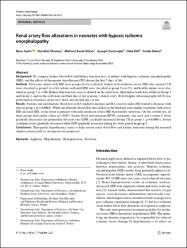Renal artery flow alterations in neonates with hypoxic ischemic encephalopathy

Göster/
Erişim
info:eu-repo/semantics/embargoedAccessTarih
2023Yazar
Aydın, BanuOkumuş, Nurullah
Özkan, Mehmet Burak
Zenciroğlu, Ayşegül
Dilli, Dilek
Beken, Serdar
Üst veri
Tüm öğe kaydını gösterKünye
Aydın, B., Okumuş, N., Özkan, M. B., Zenciroğlu, A., Dilli, D., & Beken, S. (2023). Renal artery flow alterations in neonates with hypoxic ischemic encephalopathy. Pediatric Nephrology, 1-9.Özet
Background: To compare kidney blood flow and kidney function tests in infants with hypoxic ischemic encephalopathy (HIE), and the effects of therapeutic hypothermia (TH) during the first 7 days of life.
Methods: Fifty-nine infants with HIE were prospectively evaluated. Infants with moderate-severe HIE who required TH were classified as group 1 (n = 36), infants with mild HIE were classified as group 2 (n = 23), and healthy infants were classified as group 3 (n = 60). Kidney function tests were evaluated on the sixth hour, third and seventh days of life in Group 1 and Group 2, and on the sixth hour and third day of life in group 3. Renal artery (RA) Doppler ultrasonography (dUS) was performed in all infants on the first, third, and seventh days of life.
Results: Systolic and end diastolic blood flow in RA tended to increase and RA resistive index (RI) tended to decrease with time in group 1 (p = 0.0001). While end diastolic blood flow rates in RA on the third day were similar in patients with severe HIE and mild HIE, it was lower in patients with mild-moderate-severe HIE than healthy newborns. On the seventh day, all three groups had similar values (p > 0.05). Serum blood urea nitrogen (BUN), creatinine, uric acid, and cystatin C levels gradually decreased and glomerular filtration rate (GFR) gradually increased during TH in group 1 (p = 0.0001). Serum creatinine levels gradually decreased while GFR gradually increased during the study period in group 2.
Conclusions: Therapeutic hypothermia seems to help restore renal blood flow and kidney functions during the neonatal adaptive period with its neuroprotective properties. A higher resolution version of the Graphical abstract is available as Supplementary information.















